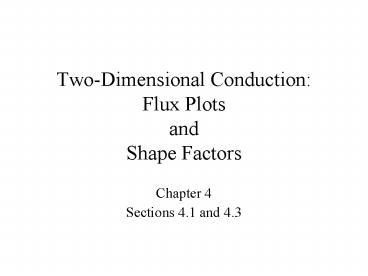TwoDimensional Conduction: Flux Plots and Shape Factors - PowerPoint PPT Presentation
1 / 11
Title:
TwoDimensional Conduction: Flux Plots and Shape Factors
Description:
Heat transfer in a long, prismatic solid with two isothermal surfaces ... Problem 4.6: Heat transfer from a hot pipe embedded eccentrically. in a solid rod. ... – PowerPoint PPT presentation
Number of Views:277
Avg rating:3.0/5.0
Title: TwoDimensional Conduction: Flux Plots and Shape Factors
1
Two-Dimensional ConductionFlux Plotsand Shape
Factors
- Chapter 4
- Sections 4.1 and 4.3
2
General Considerations
General Considerations
Note the shapes of lines of constant temperature
(isotherms) and heat flow lines (adiabats).
What is the relationship between isotherms and
heat flow lines?
3
Solution Methods
The Heat Equation and Methods of Solution
- Solution Methods
- Exact/Analytical Separation of Variables
(Section 4.2)
- Limited to simple geometries and boundary
conditions.
- Of limited value for quantitative considerations
but a quick aid to - establishing physical insights.
- Approximate/Numerical Finite-Difference,
Finite Element or Boundary - Element Method.
- Most useful approach and adaptable to any level
of complexity.
4
Flux Plots
Flux Plots
- Utility Requires delineation of isotherms and
heat flow lines. Provides a - quick means of estimating the rate of heat
flow.
- Procedure Systematic construction of nearly
perpendicular isotherms and heat - flow lines to achieve a network of
curvilinear squares.
- Rules
- On a schematic of the two-dimensional
conduction domain, identify all - lines of symmetry, which are equivalent to
adiabats and hence heat flow lines.
- Sketch approximately uniformly spaced isotherms
on the schematic, - choosing a small to moderate number in
accordance with the desired - fineness of the network and rendering them
approximately perpendicular - to all adiabats at points of intersection.
- Draw heat flow lines in accordance with
requirements for a network - of curvilinear squares.
5
Flux Plots (cont.)
Example Square channel with isothermal inner
and outer surfaces.
- Note simplification achieved by identifying
lines of symmetry.
- Requirements for curvilinear squares
- Intersection of isotherms and heat flow lines
at right angles
- Approximate equivalence of sums of opposite
sides
- Determination of heat rate
6
Shape Factor
The Conduction Shape Factor
- Two-dimensional heat transfer in a medium
bounded by two isothermal - surfaces at T1 and T2 may be represented in
terms of a conduction shape - factor S.
- For a flux plot,
- Exact and approximate results for common
two-dimensional systems are - provided in Table 4.1.
For example,
Case 6. Long (Lgtgtw) circular cylinder centered
in square solid of equal length
- Two-dimensional conduction resistance
7
Problem Flux Plot
Problem 4.6 Heat transfer from a hot pipe
embedded eccentrically in a solid rod.
8
Flux Plot
Determine the error
associated with the flux plot by using a result
from Table 4.1 to compute the
actual value of the shape factor.
9
Problem Shape Factor
Problem 4.27 Attachment of a long aluminum pin
fin (D5mm) to a base material of aluminum or
stainless steel. Determine the fin heat rate
and the junction temperature (a) without and (b)
with a junction resistance.
Schematic
10
Problem Shape Factor (cont)
11
Problem Shape Factor (cont.)































